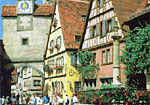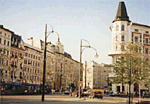Topic 3: History of Germany

Lesson 1: What were communities like in Germany long ago?
Lesson Objective
The student will explain how communities developed and grew in Germany.
Materials and Resources
 Transparency 14 - “Munich” |
 Transparency 15 - “Rothenburg” |  Transparency 16 - “Magdeburg” |
- Handout 9 - “Map of Munich”
- Handout 10 - “Important Places in Munich”
- Teacher Resource 11 - “Information on photographs of Rothenburg”
- Handout 11 - “Map of Rothenburg”
- Teacher Resource 12 - “Information on the photographs of Magdeburg”
- Handout 12 - “Map of Magdeburg”
- Handout 13 - “Important Places in Magdeburg”
- Art Supplies (markers, crayons, glue, color paper, scissors)
Introduction
If you went to Germany today, you would notice many differences from the United States, but also many similarities. In most German cities there is a lot of old buildings – many built long before the United States existed. In the old central sections of German cities and towns, the streets are narrow and crooked and are made of cobblestones instead of blacktop. Other parts of the cities have tall new buildings like the ones in the United States.
Long ago, in the Middle Ages most German communities grew up around a church and monastery or around a nobleman’s fortress. As soon as marketprivileges were granted to the towns by the sovereign princes, tradesmen and farmers frequently met at a market place to trade their various goods. In the days of the “Holy Roman Empire of the German Nation” when about 300 smaller and bigger states were competing against each other for survival, a town was usually protected by a wall with several guarded gates to prevent enemies and thieves from entering. Symbols of the wealth and prosperity of the city were made evident to visitors by the size and decoration of a church (Kirche), monastery (Kloster) or cathedral (Dom), the city hall (Rathaus), the market place with its fountain located in front of the city hall, and/or sometimes statues and monuments.
Strategies
Use Transparencies 14 “Munich,” to show students pictures of the medieval Munich: the Church of Our Lady, the Old Court of the dukes of Bavaria, the festive hall Antiquarium in the renaissance princely residence, the Old Town Hall with St. Mary’s statue in front of it, the famous Viktualien Market, and the Siegestor, a triumph arch of the 19th century. As Munich is an old and large city, it also displayed its importance and wealth by including an elaborate Glockenspiel (carillon) in the New Town Hall. Information on the photographs is also provided with Handout 10 “Important Places in Munich.” Provide the students with Handout 9 “Map of Munich” and Handout 10 “Important Places in Munich” and encourage them to find the different places, compare the town structure with other towns, and compare the historical development with others.
Transparency 15 shows the town of Rothenburg ob der Tauber (Rothenburg on the Tauber River) which still looks very much like it did in the Middle Ages and is very clean and nicely kept. The town is the most frequently visited of its type in Germany. Visitors enter the town through one of its many gates, which are part of the ancient city wall. In 1631, the town was attacked and conquered by a Swedish general. According to legend, the mayor of Rothenburg saved the town by taking the general’s challenge to drink a huge jug of wine. Nevertheless the town was almost destroyed during the Thirty Years War (1618–1648); but the city was rebuilt and maintained its charm, unharmed by many wars since that time.
The City Hall (Rathaus), a renaissance style building, is almost 500 years old and is considered one of the finest in Germany. The “Markustower” (Markusturm) was built around 1200. Until 1844 it was used as a jail. Visitors to Rothenburg stroll along cobblestone streets past half-timber homes decorated with flowers. The Plönlein, one of the most picturesque and most frequently photographed streets in Europe, is located in Rothenburg.
As a third example, introduce students to the city of Magdeburg, located on the eastern side of the Elbe River with Transparency 16.
Based on the discussion of the cities of Munich and Rothenburg, have students analyze the map, the descriptions of historic places, the time line, and the photographs and have them select 5 to 7 significant attributes of the city. The students should work in groups to create a tri-fold brochure on an 8 1/2” x 14” sheet of paper. The brochure should entice the reader to visit the city by identifying some of its traditional sites (e.g. the castle, church, city hall), their location, and a brief description of their history.
Activities
- Discuss the way cities were designed and built in Germany centuries ago. You could draw a map or even “rebuild” a typical German town with its town hall, city wall, church, market place, etc. Ask your class why they think a city was set up that way, e.g. why was it advantageous to place the town hall right in the middle of the city?
- Take a look at your own town: are the buildings set up in a similar way? If yes/no, why do your students think that is the case?
- Some features of a city were necessary defensive buildings (e.g. city wall), others were used to show a city’s wealth (e.g. the Glockenspiel in Munich). Ask your students to set up their own town using 2 defensive buildings, 2 features showing wealth and prosperity and 2 buildings of their choice (plus the roads, houses, places, squares).
- Compare the city of Munich to the city of Magdeburg. Try to find out similarities and differences and discuss them.
- Ask your student to pick their favourite German town. Why, for example, would they like to live there and which building would they choose to live in. If your students have a vivid imagination, you could furthermore ask them to choose a time-period (e.g. Middle Ages, Renaissance, the present...)
- Take a look at your own town: are the buildings set up in a similar way? If yes/no, why do your students think that is the case?

 Printable PDF
Printable PDF